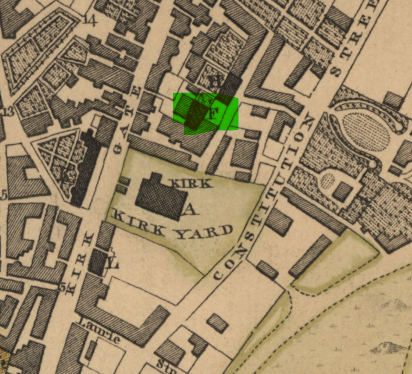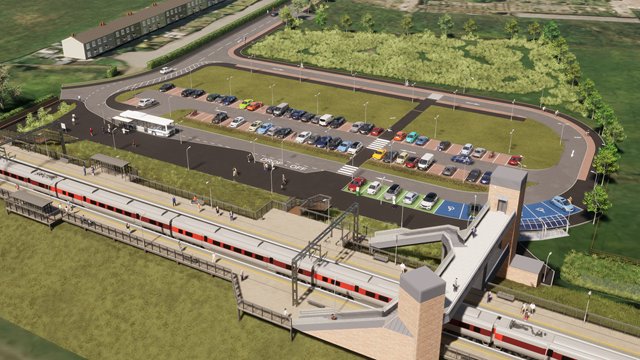
Today's Auction House Artefact is very topical given it's the 31st October. No, it's nothing to do with Halowe'en, sorry. It's a Communion Token and of course today is also Reformation Day. 



It's just a small, roughly cast pewter token. But what is it, and what does it have to do with my usual subjects of interest. Well, obviously it's marked LEITH, so that's a start.
Starting on what communion tokens are (and I'm no expert here, so do wade in if I'm wrong). They are peculiar to Reformed churches and the concept dates all the way back to John Calvin in the 16th Century.
They were first issued in the Netherlands, but really became a thing of the Scottish reformed Kirk and all its various offshoots. There are at least 5,000 known different Communion tokens specific to Scottish churches.
A communion token was a method to identify members of a congregation to practice "closed communion"; i.e. only members of the congregation can participate. No token? No communion. Tokens were issued to those who had taken the necessary catechism.
Back to our token. What do the abbreviations mean? On the right, it says "Associate Congregation". On the left it says "Minister, J. S. (John Sharp). The date of 1825 was not the date of issue I think, but the date the Rev. Sharp took over the congregation. 

And here is an earlier issue, for Sharp's predecessor, Robert Culbertson, who served from 1791 until his untimely death in 1823. 

So what is an Associate Congregation and why is it interesting I hear you say? Well to answer that you heave to delve into the amusingly elaborate timeline of the various reformed churches in Scotland since the (Scottish) reformation 

If you go way back to 1733, some congregations began to secede from the Church of Scotland ("the Kirk"). The "seceders" left for various long standing and unresolved reasons, particularly the threat of patronage to prevent a congregation choosing its own minister 

The Seceders were led by Ebenezer Erskine, minister in Stirling, formed their own church court, known as the Associate Presbytery. They were summoned to answer by The Kirk in 1739 but refused as they did not recognise its authority over them, so were deposed. 

This had two effects. Firstly, the seceder congregations were ejected from their churches so had to find new homes. It also rallied parisioners to their cause and the new churches ranks were swelled. At this time I'm not sure what presence, if any, they had in Leith.
By 1745, the Associate Presbytery numbered 45 congregations. But by its very nature it attracted uncompromising and opinionated ministers and so it didn't take long for everyone to fall out.
So in 1747 the inevitable happened and there was a split within the ranks of the splitters.
This split was around a religious clause in the oath that burgesses had to take. The burgesses were the "freemen" of the burgh, an important position in Scottish society at the time. The "Burgher Oath" had to be taken in the royal burghs of Edinburgh, Glasgow and Perth.
The hardliners refused to take the oath as they felt it would mean that they recognised the authority of The Kirk. The result was that the General Associate Synod split off of the Associate Synod, these two sects are better known as the Antiburghers and Burghers.
So if you're following all this, we now have the General Associate Synod (Antiburghers) and the Associate Synod (Burghers)
So this is why you get those odd things on old maps (such as this 1784 town plan of Edinburgh, via NLS) called Burger Meeting and Antiburger Meeting houses (or on earlier versions i.e. 1765, the Seceder's Meeting House). 





Maps of this time refer to "meeting houses" or "chapels". I assume because they were not officially recognised by the mapmakers as churches in their own right. Any from the maps we can see a Seceders' church on Bristo Street in 1765 and by 1784 the Antiburghers have their own.
If you're still following, give yourself a pat on the back, because it's about to get even more confusing...
But before then, let's go back to Leith. The first Antiburgher Church was formed in the Kirkgate in Leith in 1766 following a stushie within the South Leith Kirk over the appointment of the new minister William Aitken.
They met in a meeting house on Cables Wynd, ordaining a minister John Proudfoot in 1772. Funds were raised to erect a purpose built church on the Kirkgate just over the wall from South Leith Kirk, which was completed in 1775. 

In 1785, the Rev. Proudfoot was suspended by the Antiburgher synod and deposed. This caused a split within his congregation. Some members returned to South Leith Kirk, but most stayed with Proudfoot as a "free" Antiburgher church.
Proudfoot died in 1787 and his Antiburgher congregation petitioned the Burghers to join. This was granted and so once again there was a split, and the Antiburghers left to do their own thing, leaving the Burghers in the Kirkgate.
The Antiburghers who left the Kirkgate petitioned the Antiburgher church and were welcomed back in and a new congregation was established in the old Glasite Meeting House (let's not go there) off of St. Andrew's Street, becoming the St. Andrew's Street Antiburghers. 



(The St. Andrew's Street Antiburghers did a great Peel Session back in '77 by the way) Anyway, in 1791, they appointed Robert Culbertson as their minister, and he was quite the scholar and patron of many things. He was notable enough to be subject to a caricature by John Kay. 

His church was an Associated Congregation, i.e. a member of the General Associated Synod, hence the stamp on the communion tokens. In 1798 however, resulting in the Auld Lichts and the New Lichts (old and new lights). The same happened to the Burghers 8 years later. 

Culbertson was a New Licht Antiburgher, more theologically liberal than the Auld Lichts who held more strictly to Calvin and the Covenanting tradition. He was a popular and influential minister and donated heavily to the Edinburgh Bible Society and the Leith Public Library.
Soon, the New Lichts of the Burgher and Antiburgher churches realised what united them was greater than what divided them, and a union took place. Culbertson was on the negotiation committee and "greatly rejoiced" on its success. The result was the United Secession Church of 1820 

Culbertson died an untimely death in 1823, falling ill during a meeting of the presbytery of the new United Secession Church. He did not live to see his congregations grand new church which was not completed until 1826.
That church was built on land acquired from the city next to the High School of Leith, built by John and James Rutherford in the classical style. The St. Andrew's Street Congregation named the new street St. Andrew's Place after their church. 

(that building is now the B-listed Edinburgh Hindu Mandir & Cultural Centre, and it is their picture by the way).
In 1825, Culbertson's vacant pulpit was filled by the Rev. John Smart (1801-1871), who initially lived opposite on Morton Street. This print of him is by Thomas Dick and is in the collection of the National Gallery of Scotland. 

Smart was minister until 1845. In 1847 the United Secession Church merged with another split off of the Kirk, the Relief Church of 1761, to form the United Presbyterian Church, which is what all those "UP Churches" are on Victorian maps of Scottish towns and cities. 

So in 1849 (OS Town plan, via NLS), the Antiburgher church is now the St. Andrew's United Presbyterian Church, "seats for 1400" (the established South Leith Kirk only had 1200). The original hall was half that size and kept on as a meeting place. 



Remarkably, a photo exists of the original meeting house off St. Andrew's Street. It was actually on Storrie's Alley. It is seen here in the early 1960s when it was used by the YMCA, before being swept away. flickr.com/photos/sixties…
The French-style roofline of Yardheads School is the giveaway of the location. The hall stood infront of the remaining old buildings, a former bonded warehouse. 



In the late 1880s/early 1890s, the St. Andrew's Place congregation opened a mission hall on Jane Street, a charming little building which is still there and is some sort of hotel/hostel thing. 

Back to our diagram. In 1900, the U.P. Church joined with the Free Church (of the ominous sounding "Disruption of 1843") to form the United Free Church. By this time, the Kirkgate Congregation was also in this fold. 

The Kirkgate congregation had by this time moved to a new and altogether grander premises on Henderson Street (pic © Edinburgh City Libraries). While it has unfortunately been demolished, that carving above the door and the cross survive on the modern South Leith church halls. 





In another picture from Edinburgh City Libraries (capitalcollections.org.uk/view-item?key=…) here we see the entrance to Storrie's Alley off of St. Andrew's Street. In amongst all the Victoriana we see a lantern pointing the way to the St. Andrew's Hall. 

The St. Andrews associate congregation completed its 360 degree journey in 1929 when it was one of the United Free Church congregations that merged back into The Kirk, becoming Leith St. Andrews. 

In 1973 it joined with the Claremont Church of Scotland at the foot of Easter/ Lochend Roads and relocated to the latter premises, which took up the name of St. Andrew (pic © Alan Murray-Rust via Geoograph) 

When the Kirkgate associate congregation moved to its new home on Henderson Street in 1886, the old church became the Princess Theatre and music hall, which burned down 2 years later as such places often did. The New Princess, later the Gaiety, rose from the ashes (maps NLS) 



The Kirkgate Congregation followed the route of St. Andrew's Place, and returned to the Church of Scotland in 1929, merging with the South Leith congregation in 1973. The Kirkgate church was demolished and replaced by the South Leith church halls.
Anyway, if you've got through all that, and are still following, well done! I got lost multiple times myself and have spent much of today trying to get my head around it.
Anyway, the moral of the story is that even if you are not religiously inclined it pays to get your head around at least a bit of it as it really helps understand maps and buildings and local history. Especially the question "why did the Victorians build so many dang churches" 🔚
• • •
Missing some Tweet in this thread? You can try to
force a refresh




















